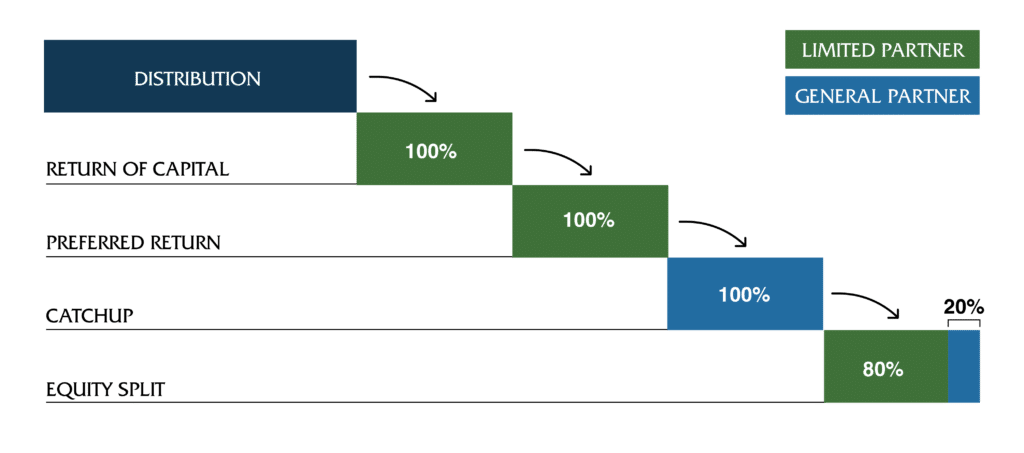European waterfall might evoke recollections of Langfoss, Stuibenfall, or Mardalsfossen. But that’s not what this article is about.
Instead of diving into a plunge pool, we will examine how profits from private equity are distributed. More specifically, we will compare and contrast the American Waterfall with the European Waterfall. But first, let’s define some terms.
What Is A Waterfall And Who Is Involved?
A waterfall is a legal term that describes how profits are distributed within a partnership, corporation, or limited liability company (LLC). In essence, the accumulated capital gains are allocated following a tiered arrangement that cascades sequentially, giving rise to the term “waterfall.”
When it comes to private real estate individual properties and funds, the interested parties in the waterfall are the investors and the sponsors.
If the legal structure is a limited partnership, the sponsor is the general partner, and the investors are limited partners. If it’s an LLC, the sponsor is the managing member, and the investors are called members.
In this article, we will interchangeably use sponsor, general partner, and managing member to describe the group that brings the investment to market, manages it, and is responsible for any liability.
Investors have no management responsibilities and carry no personal liability. This article will refer to them as investors, fractional investors, limited partners, or members.
Since investors and sponsors want to make money, it is critically important to understand the waterfall.
Want to learn how you can get stable tax-advantaged income and equity growth in today’s market?
Get access to our newest investment platform:
Waterfall Tiers
The interested parties must divide the profits from the successful disposition of a property. They do that using the distribution waterfall, the roadmap for splitting the profits.
The waterfall delineates who gets what and the order in which they receive it. It’s a tiered cash flow structure in which the top tier receives priority. Once that obligation is met, then cash flows to the next tier. This continues to subordinate tiers until all of the profits are distributed.
The Typical Distribution Model
When evaluating private real estate offerings, you’ll encounter multiple variations of equity waterfalls. However, the most common structure is a four-tiered structure.
Return of Capital – Tier #1
Returning the investor’s original capital contributions is the top tier and highest priority of well-designed distribution waterfalls. Whether you’re growth or income-focused, you invest your hard-earned money into these investments, and the return of that initial investment should be priority number one.
Well-constructed distribution waterfalls return 100% of invested capital in the top tier before moving to tier two.
Preferred Return – Tier #2
After the limited partners receive their return of capital, the next tier is typically a preferred return. The preferred rate varies from deal to deal but often falls in the 6% – 8% annualized range.
Consequently, 100% of the profits flow to the investors again in tier two to meet this obligation. The ongoing cash flow distributions that the investors receive during the operational phase of the investment typically count toward this tier.
It’s essential to ensure the preferred return is accrued as an investor.
It’s typical for these investments not to hit their preferred rate of return early in their life cycle. But if the preferred return is accrued, the sponsor still owes that money, which will be paid in future distributions or upon successful property liquidation.
General Partner Catch-Up – Tier #3
The sponsor can participate in the distribution waterfall once the investors have received their initial capital investment and a preferred return. In this tier, 100% of distributions go to the general partner up to a prescribed amount.
Since the sponsor’s profits are subordinate to the investors, it’s time to allow them to “catch up.”
Remaining Equity Split – Tier #4
After fulfilling the top three tiers, it’s time for tier four. The investors and sponsor will split any remaining funds. The terms of that split can vary significantly, but common splits are 70% investors / 30% sponsor and 80% investors / 20% sponsor.
Whatever the Limited Partnership Agreement or Operating Agreement spells out in this tier, an important principle is that the investors should receive the bulk of the investment returns.
The European Waterfall
The above description outlines the distribution waterfall most commonly seen in Europe. This European waterfall can have fewer tiers as the catch-up tier is optional. It can also have more tiers.
But what’s important about the European waterfall is that it protects investors. By ensuring that the investors get 100% of the distributions in the top tiers, the European waterfall aligns the investors’ interests with the sponsors.
In this distribution model, the general partner cannot participate in the profits until they’ve satisfied the hurdles of returning the investors’ initial capital investment and their annualized preferred return.
If they don’t meet these obligations, they can’t participate in the equity split (promote), which is the bulk of their compensation.

Source: European Distribution Waterfall
The European Waterfall Example
The best way to understand the European waterfall is to look at an example. So let’s say one hundred members invested $100,000 each for a 1.0% fractional share in a multifamily real estate property with a 7% preferred return.
That means that the capital raised for this property was $10 million.
This offering has a European waterfall but does not have a catch-up tier. Also, the equity split is 80% investors and 20% sponsors. The hold period was five years, producing the following results:
First-year cash flow 3.0%
Second-year cash flow 3.9%
Third-year cash flow 4.4%
Fourth-year cash flow 5.2%
Fifth-year cash flow 6.5%
Total Distributions 23%
The property sells after a five-year hold, resulting in a $5 million profit after expenses. Therefore, $15 million ($5 million profit plus $10 million in equity from the initial down payment) needs to be distributed. The dispersion of these funds using a European waterfall would be as follows.
Tier One (Return of Capital)
In the first tier, only the investors participate, receiving 100% of the profits. That means that $10 million returns to the investors, giving each investor back their initial investment of $100,000. This leaves $5 million to spill over into tier two.
Tier Two (Preferred Return)
A 7% annualized preferred return entitles the investors to 35% (5 years x 7%) in total. The previously distributed cash flows add up to 23%, leaving 12% more to satisfy the preferred return.
In this example, the investors would receive another $12,000 each, in addition to the $23,000 they’ve already received in prior cash flow distributions, for a total of $35,000.
Again, the investors received 100% of the distributions in this tier. And $12,000 to one hundred investors is $1.2 million dollars. That leaves $3.8 million to spill over into the third and final tier.
Equity Split (Tier Three)
In this example, an 80/20 equity split requires 80% of the remaining equity to go to the investors and 20% to the sponsor.
Eighty percent of $3.8 million is $3,040,000. Dividing that number by a hundred investors gives each investor an additional $30,400.
Summary Of Hypothetical Property Using A European Waterfall:
This hypothetical property made the following distributions to its investors.
Return of Capital $100,000
7% Annualized Preferred Return $35,000
80% Equity Split $30,400
Total $165,400
In this scenario, the investor received a total return on investment of 65.40%, which is 13.08% per year.
Taxes for Waterfall Equity Distributions
There are many potential tax incentives for real estate investing that can be realized throughout the investment and during a waterfall equity distribution after the sale of a property. The taxation of waterfall equity distributions is complex, depending on factors like the investment structure, the individual investor’s tax situation, and whether or not they’ll participate in a 1031 Exchange.
Due to this complexity, consulting a tax professional or financial advisor familiar with the specific circumstances is crucial for proper tax planning and compliance.
The American Waterfall
In contrast to the European waterfall, the other distribution waterfall you’ll encounter is the American waterfall. As the name suggests, it’s the most common equity waterfall in the United States.
While the European waterfall is considered investor-friendly, the American waterfall is sponsor-friendly. It’s similar to the European waterfall model, except it allows the sponsor to participate in compensation on an equal footing (pari passu) with the investors. In this model, the sponsor is not required to subordinate their compensation.
With the European model, the sponsor must wait for the later tiers (catch-up and equity split) to receive compensation. In the American model, sponsors can create opportunities to receive compensation in the earlier tiers so they don’t have to wait years to get paid.
American and European Waterfall Structures
37th Parallel Properties prefers the European waterfall distribution model because it is best for investors. Prioritizing investors’ profits over the sponsor’s profits provides the investors with a measure of safety. It also aligns the sponsor’s interests with the investor’s because the sponsor can’t receive their promotion (equity split) without first performing well for the investors.
This article simplifies a complex topic. There are countless ways to craft a waterfall distribution structure. Reading through the private placement memorandum (PPM) and understanding the equity waterfall model before investing is essential.
And if you’re going to invest in an offering that employs an American waterfall, be sure that it includes a clawback provision that allows investors to receive all or a portion of the proceeds that the sponsor received early on should the investment underperform.
37th Parallel Properties Income & Total Return Funds
37th Parallel Properties is a private real estate acquisition and asset management company specializing in multifamily real estate.
We’ve been in business since 2008 and have maintained a 100% profitable track record over more than a billion dollars in transaction volume.
We’ve made our investors money in good times and bad, in bull markets and bear markets, and across multiple recessions. That’s because we know what works and put our investors first. We write articles like this one because we believe it is essential to help educate current and potential investors about the more nuanced aspects of real estate investing.
We employ a diversified fund model, and our latest investment offering is structured using a European waterfall. We’ve even eliminated the sponsor catch-up tier because we focus on you.
We’re here to make you money, so schedule a time to speak with a team member and learn more about the 37th Parallel Advantage.
